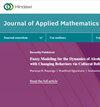基于ADMM的振动信号稀疏优化
IF 1.3
Q2 MATHEMATICS, APPLIED
引用次数: 1
摘要
本文将乘法器交替方向法(ADMM)算法应用于压缩感知理论,实现了振动信号的稀疏优化。ADMM算法解决了在等式约束下最小化范数最小化的基寻址问题,通过稀疏正交矩阵逆反演重构稀疏矩阵。本文对重构结果分析了常见的稀疏正交基,即离散傅立叶正交基、离散余弦正交基和离散小波正交基。特别地,我们将证明,从集中趋势的角度来看,离散余弦正交基更适合,例如,在振动信号数据上,因为它的误差接近于零。此外,用离散小波变换进行信号重构仍然存在一些异常值,但误差不稳定。我们还利用时间复杂度和有效性,对ADMM算法应用于稀疏信号优化的优缺点进行了分析。这种方法的优点是这些异常值被限制在控制范围内。本文章由计算机程序翻译,如有差异,请以英文原文为准。
Sparse Optimization of Vibration Signal by ADMM
In this paper, the alternating direction method of multipliers (ADMM) algorithm is applied to the compressed sensing theory to realize the sparse optimization of vibration signal. Solving the basis pursuit problem for minimizing the norm minimization under the equality constraints, the sparse matrix obtained by the ADMM algorithm can be reconstructed by inverse sparse orthogonal matrix inversion. This paper analyzes common sparse orthogonal basis on the reconstruction results, that is, discrete Fourier orthogonal basis, discrete cosine orthogonal basis, and discrete wavelet orthogonal basis. In particular, we will show that, from the point of view of central tendency, the discrete cosine orthogonal basis is more suitable, for instance, at the vibration signal data because its error is close to zero. Moreover, using the discrete wavelet transform in signal reconstruction there still are some outliers but the error is unstable. We also use the time complex degree and validity, for the analysis of the advantages and disadvantages of the ADMM algorithm applied to sparse signal optimization. The advantage of this method is that these abnormal values are limited in the control range.
求助全文
通过发布文献求助,成功后即可免费获取论文全文。
去求助
来源期刊

Journal of Applied Mathematics
MATHEMATICS, APPLIED-
CiteScore
2.70
自引率
0.00%
发文量
58
审稿时长
3.2 months
期刊介绍:
Journal of Applied Mathematics is a refereed journal devoted to the publication of original research papers and review articles in all areas of applied, computational, and industrial mathematics.
 求助内容:
求助内容: 应助结果提醒方式:
应助结果提醒方式:


